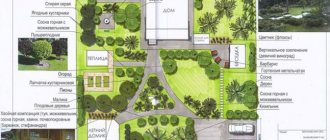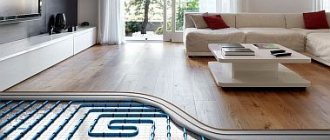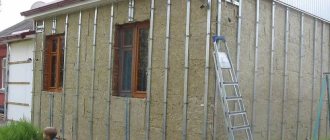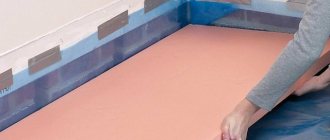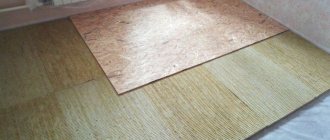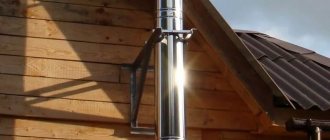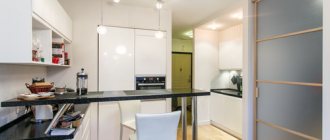What is polystyrene concrete and is it suitable for floor screed?
Firstly, polystyrene concrete is similar in characteristics to classic concrete filled with crushed stone or other stone (in full compliance with the set of rules SP 29.13330.2011). Secondly, it has a number of advantages at comparable costs for the components of the concrete mixture. Moreover, polypropylene granules of various diameters are available for free sale.
Composition of polystyrene concrete:
- Portland cement grade 400-500 as a binder;
- filler made of polystyrene foam granules, which accounts for up to 85% of the total volume of materials;
- in some cases, washed sand to give increased strength to the finished screed;
- plasticizer to prevent granules from floating when stirred.
The proportions of the components are selected based on the required density of the solution. Basically, they change the volume of cement - the more of it in one cubic meter of polystyrene concrete, the stronger the screed will be. But at the same time the weight of the finished base increases. This is taken into account when pouring floors, when there is a limitation on the load capacity of the floors. The only exception is the first floors of buildings that do not have basements.
Let's summarize what has been said
So, which of the two designated genders is better? It’s not even worth arguing here, because both wooden and concrete ones are used everywhere. It’s just that everyone sets certain goals for themselves, usually related to the financial situation. If the budget allocated for the construction of a bathhouse is large, then a concrete base can be poured. If there is not much money, then it is better to lay a plank structure. Of course, in the latter case, you will first have to decide the question of which boards are best for the floor in the bathhouse. And here again everything comes down to the financial component.
Advantages and disadvantages of the material as a floor screed
Due to its lightweight filler, polystyrene concrete is lighter in weight compared to its analogues. Therefore, it is better suited for screeding floors in an apartment or house on the second level and above, including on wooden floors, instead of wooden boards on joists. Lightweight concrete shrinks less and puts less load on the foundation and load-bearing walls.
There are also advantages:
- the screed dampens sounds up to 70 dB (depending on the thickness);
- every 10 cm of polystyrene concrete is equivalent to 30 cm of ordinary concrete;
- floors last a long time at temperatures from -60°C to +70°C;
- The material is not afraid of moisture, mold, fungi.
Among the disadvantages, they note the need to use special dowels and anchors when fastening various structures. During subsequent work, it is recommended to avoid exposing the screed to organic solvents such as gasoline or acetone (they will ruin the polystyrene granules). But the floors do not require costs for insulation and waterproofing. The finishing self-leveling screed is immediately poured onto the surface and the flooring is laid.
Advantages of using polystyrene foam
Many experts consider foam plastic an ideal material for floor insulation. It is quite affordable and boasts many useful properties:
- high level of thermal insulation - polystyrene foam retains heat well, which is due to its structure consisting of round granules. There is an air cushion between them that prevents the leakage of warm air;
- excellent level of sound insulation - the foam layer in the floor screed will protect the neighbors below from various noises, primarily from the sounds of footsteps;
- fire resistance - this material is characterized by a short burning period and has the ability to self-extinguish. Even if during a strong fire the fire reaches the foam layer, no harmful compounds will be released when heated;
- long service life - foam plastic is not subject to shrinkage, rotting and can last for several decades without losing its characteristics.
Polystyrene foam is perfect for floor insulation
All these properties make this material an excellent solution for floor insulation. In addition to all of the above, it is easy to machine and is extremely simple to use.
Characteristics of foam plastic
| Brand of foam boards | PSB-S15 | PSB-S25 | PSB-S25F | PSB-S35 | PSB-S50 |
| Material density, kg/m3 | 10-11 | 15-16 | 16-17 | 25-27 | 35-37 |
| Compressive strength at 10% linear deformation, MPa, not less | 0,05 | 0,1 | 0,12 | 0,16 | 0,16 |
| Bending strength, MPa, not less | 0,07 | 0,18 | 0,2 | 0,25 | 0,3 |
| Thermal conductivity in dry condition at a temperature of 25 (+-5 degrees), W / (m * K), no more | 0,037 | 0,035 | 0,037 | 0,033 | 0,041 |
| Humidity of slabs, %, no more | 1 | 1 | 1 | 1 | 1 |
| Self-combustion time, sec, no more | 3 | 3 | 3 | 3 | 3 |
| Water absorption in 24 hours, %, no more | 1 | 1 | 1 | 1 | 1 |
| Service life, years (minimum-maximum) | 20-50 | 20-50 | 20-50 | 20-50 | 20-50 |
Types of polystyrene concrete screeds
Due to the characteristics of the main filler - polystyrene granules, dry and semi-dry floor screeds cannot be made with it. Otherwise, the floor surface will “play” and be too floating under load. And short-lived compared to wet, which involves preliminary mixing of a concrete mixture with water, cement, and sometimes sand. But screeds made of polystyrene concrete differ in purpose.
There are two options:
- Thermal insulation. Performed under or above a classic concrete floor for better heat retention. It is characterized by an increased volume of granules, increased plasticity and resistance to a humid environment. Designed for weights up to 250-500 kg per cubic meter. m.
- Structural and thermal insulation. Assumes a denser solution, weighing 600 kg per 1 m³. Such a screed will be durable and resistant to abrasion, but it will retain heat less well.
The density of polystyrene concrete for the first type of floor screed is lower, so a finishing compound or ordinary concrete must be poured on top of it, which increases the rigidity of the flooring. It can withstand mechanical loads better, including shock. Plus, the polystyrene layer is completely protected from the risks of damage from household and construction chemicals, and exposure to open fire.
There is also a division according to the method of using granules. In the first case, a layer of polystyrene is poured in the form of a cushion under the concrete screed. In the second, the components are pre-mixed in a concrete mixer or a special installation, which then automatically delivers the solution to the right place (through a special hose).
Composition of the solution
The easiest way is to use ready-made mixtures in bags indicating the brand of polystyrene concrete. Their composition makes it possible to obtain a solution with the same quality regardless of the volume (area and thickness of the screed). Since our article is about preparing the solution yourself, we will give examples of mixing.
An example of the composition of the D200-D300 brand:
- cement – 160 kg;
- polystyrene granules – 30 kg;
- water – 100 l;
- plasticizer – 1 kg.
Sand begins to be added to solutions of the D600 brand, which are higher in mechanical strength than in the example given. It is recommended to use washed, sifted material to prevent the formation of unstirred lumps. They will reduce the strength of the screed until potholes appear during operation. A uniformly mixed composition will serve no less than classic concrete made from a sand-cement-crushed stone mixture.
Foaming additives are needed to improve the adhesion of granules with cement mortar, which thanks to them envelops their surface. As a result, polypropylene is distributed evenly throughout the total mass of concrete, without the formation of “clumps” with reduced mechanical strength. Instead of a plasticizer, liquid soap or detergent is sometimes added.
Characteristics of cement bonded particle boards
DSP has a multilayer structure, as it is made by pressing from small shavings, wood fibers, cement, and plasticizers. This is a universal material that is used for various construction and repair work in any climate for any finish. It is not completely perfect, but it has a lot of advantages:
- High resistance to mechanical stress. Its mechanical strength is 3 times higher than the strength of chipboard.
- Immunity to the appearance of mold and fungi due to the alkaline environment.
- Ability to withstand humidity and critical temperatures.
- Fire safety due to the presence of additives in the composition that reduce the risk of fire.
- Long service life.
- Convenient installation, ease of drilling, fastening, cutting.
- There is no need for additional leveling - the surface is flat and smooth.
- Environmentally friendly - it contains natural wood and cement.
- Good noise insulation (up to 30dB).
- Low cost due to simple manufacturing technology; the formation of voids and internal defects is excluded during production.
There are only two disadvantages: when cutting the material, cement dust is released, and during installation, the large weight of the slab causes inconvenience.
Considering the characteristics of the material and the manufacturing method, it becomes clear why DSP laid on a wooden floor is popular.
Materials and equipment for making the solution
The technology by which polystyrene concrete is produced is based on mixing the specified components until a uniform mass is achieved. It is imperative to ensure that the mixture does not contain granules that are not moistened with cement solution. If you plan to make concrete screed grade D600 or higher, you will need to add the appropriate amount of quartz sand.
Equipment for mixing mortar:
- Concrete mixer. Involves manual mixing, unloading of the finished material, and transfer to the site. Productivity depends on the speed of the operator.
- Construction mixer. Useful for making a small volume of polystyrene concrete when finishing or redoing a floor. For example, after dismantling part of it.
- Mobile station. It has a capacity of up to 80 m3 per shift, supplying 8-10 m3 of liquid polystyrene concrete per hour.
The third option is preferable because with it the work goes faster and it is easier to plan. In addition, such equipment is usually rented by our company. When the contract is signed, the equipment is delivered to the site along with the construction materials. All that remains is to prepare the place for pouring in advance and agree on the time of work.
The mobile station will simplify the filling of a large floor area. In the case of a concrete mixer, after laying each batch, you have to wait for the next batch to be mixed. During this time, the material slightly sets and as a result the surface turns out to be “not monolithic”. Continuous supply of concrete allows you to obtain a flat surface over the entire area of the room.
Properties of DSP
Cement particle board for flooring combines all the advantages of building materials such as OSB, chipboard, plasterboard and fiberboard, and in some respects it surpasses them:
- Thanks to its multilayer structure, DSP has high strength, similar to OSB. This figure is higher than that of GVL.
- Since the slab has a smooth and even surface, it does not require additional processing before installing the final finish. With this quality, cement products have much in common with chipboard, OSB and plasterboard (about
Proportions
The composition of the polystyrene concrete solution affects the technical characteristics of the finished material. So, the mechanical strength of the screed depends on the amount of cement. As the diameter of the granules increases, the sound and heat insulating properties increase, but the concrete becomes more plastic and requires pouring over a “reinforcing” finishing layer.
Approximate composition:
- polystyrene granules - 1 cubic meter. m;
- cement – 290 kg;
- water – 120 l;
- plasticizer – 0.7 l.
As the grade of polystyrene concrete increases, the volume of sand, Portland cement and water added increases (sand is needed for grade D600 and higher). Less plasticizer is used. At the same time, the mass of 1 cubic meter of the mixture also increases; this must be taken into account when calculating the load on the floors. When pouring the first floor, it does not play a special role (provided there are no basements).
conclusions
When choosing a material for installing a floor, it is difficult to immediately answer the question of which is better: OSB or plywood. There are many factors that determine the characteristics of sheets. Both varieties have similar properties, are durable, tolerate contact with moisture, but can behave differently under the same conditions.
When installing plywood, the coating does not bend, because this material fits well and does not “play” under pressure. It better withstands mechanical loads, but does not have sound insulation, and therefore requires the use of substrates. OSB is a sheet that is distinguished by its versatility, which is due to its low content of harmful components and affordable price.
Kneading process
Due to the characteristics of polystyrene granules, the procedure must follow the sequence of laying the components. So, they begin work by adding cement and water in a ratio of 1:2 to obtain a liquid solution. Then a plasticizer is added (fumed wood resin such as SDO or detergent). Approximately 20 ml is poured into each bucket of water. Sometimes the finished mixture is immediately poured into the primary solution. This approach allows you to mix it evenly.
Next steps:
- Pour in polystyrene granules (measure the volume in advance).
- Stir until their surface is evenly wetted.
- Pour in the remaining cement, pour in the remaining water.
- Mix the solution until completely ready.
If the recipe requires the addition of sand, a means of accelerating setting, they are added simultaneously with the second batch of cement. The higher the grade of polystyrene concrete, the longer the mixing process will take (due to the hardness and thickness of the mixture). When mixing “manually” with a mixer, it is important to achieve uniformity of the mass throughout the entire volume of the container.
When using a mobile station, it is enough to follow the boot sequence. After the cycle is completed, the polystyrene concrete will be ready to be pumped to the screed site. Immediately after the tank is empty, it is ready to load the next batch of material. If you buy a ready-made mixture, it’s easy to put the production on stream (as long as there are enough workers).
Useful tips
To achieve better results, you can use some recommendations:
- Installing DSP on the floor is most important when laying tiles: in this case, the highest quality adhesion is achieved.
- Before use, it is better to keep the material indoors for 24 hours. This will eliminate possible errors.
- If work is carried out on a “wet” screed, then you should wait for it to dry completely.
- It is better to carry out the procedures with an assistant, especially when using thick slabs.
If all work is performed correctly, the surface will be more reliable.
Filling and Alignment
The process of pouring a polystyrene concrete floor screed is similar in sequence to conventional concrete. So, the room is pre-prepared - the surface is cleared of debris and large contaminants, horizontal beacons are set, and a damper tape is laid along the perimeter. Before pouring, it is recommended to moisten the entire area generously with water.
Stages:
- finished polystyrene concrete is laid between the beacons;
- the floor surface is pre-leveled;
- After about a day, the beacons are dismantled;
- the cavities are filled with the same solution.
All that remains is to wait until the concrete mixture hardens completely (up to 28 days) and it is ready for further work. Typically, the next step is to fill the finishing screed with a self-leveling mixture to hide the “bumps” formed by the polystyrene granules. This layer also creates a denser surface on which the substrate and finishing coating are laid.
The use of polystyrene concrete is used to solve several problems at once.
Thus, it is possible to fill the floor instead of using a plank covering and not particularly load the floors. Plus, get rid of the need to spend on additional insulation and sound insulation. It is also easier to bring the required amount of material into the apartment than in the case of mixing concrete based on crushed stone. BACK TO LIST
Laying technology for leaking wooden floors
A step-by-step guide to installing a leaking floor provides for step-by-step work: preparing the underground, installing joists and wooden flooring.
Preparation of the underground
In order for water entering the underground to be discharged into the ground, it is necessary to properly prepare the base - for this, the top layer of soil is cut off and a waterproofing cushion made of small crushed stone up to 26 cm thick is backfilled.
For soils with a low level of moisture absorption, soil removal is carried out at a slight angle, and wastewater is discharged into a 30-centimeter pit through a drain pipe. The soil is covered with clay and leveled.
Important! Before backfilling the pillows, supports are installed under wooden logs, and a foundation is erected for heating equipment.
Installation of support beams
How to install logs correctly? They are mounted on concrete supports equipped with a brick stand. The height of the lag is determined by the height of the pillars (column foundation) or strips (strip foundation).
The installation of the logs is carried out opposite the short wall of the building. To avoid deformation of the joists or their swelling, the supports are covered with a double layer of waterproofing made of roofing felt treated with hot bitumen.
To ensure natural ventilation when laying logs to the walls, a minimum technological gap of 4 cm should be observed.
Wood flooring
To lay the floor, use boards that are fixed perpendicular to the installed joists. In this case, it is necessary to maintain 5 mm gaps between individual floor elements and 2.5 cm between boards and walls. The wooden panel is fixed to the joists using metal nails.



